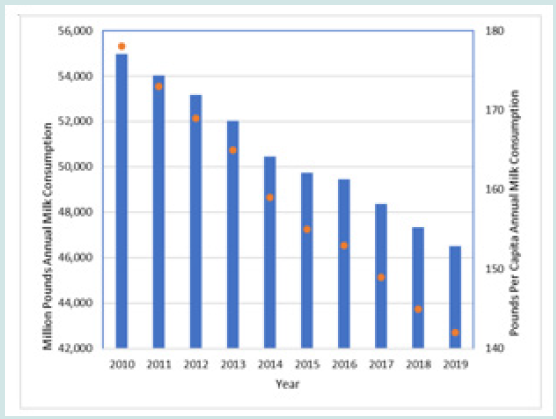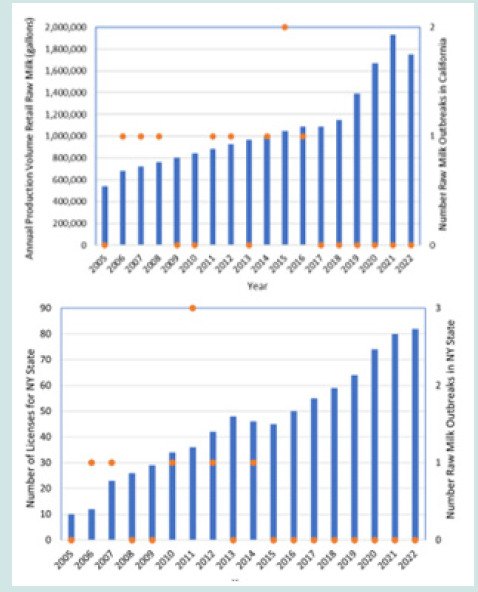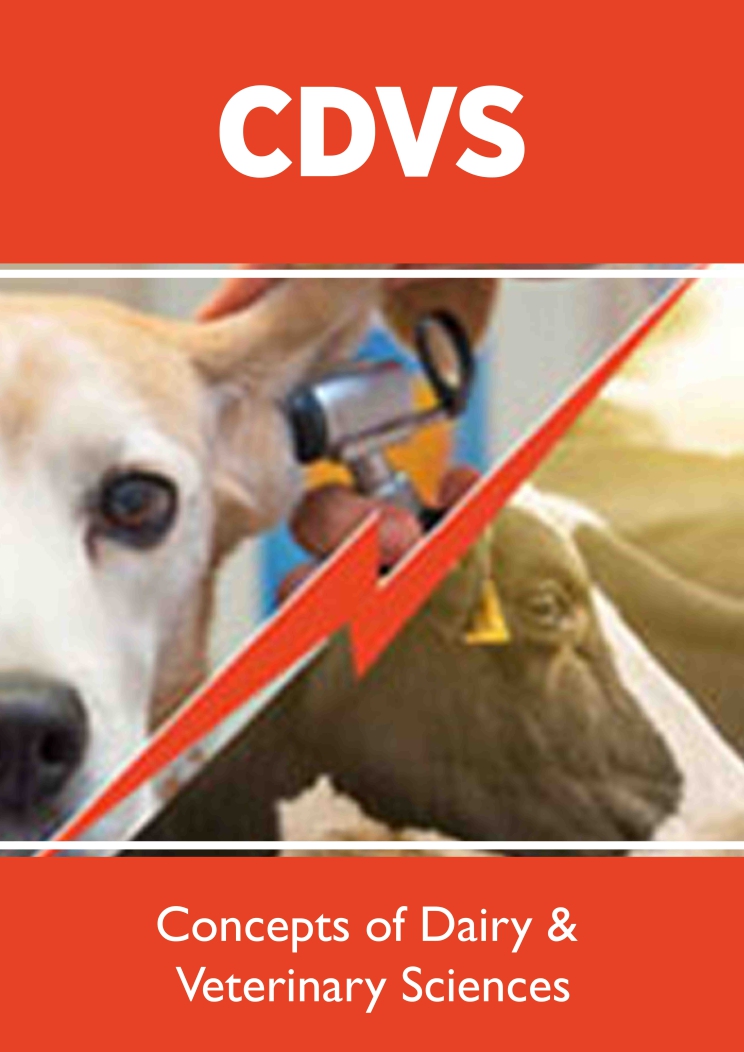
Lupine Publishers Group
Lupine Publishers
Menu
ISSN: 2637-4749
Opinion(ISSN: 2637-4749) 
Revisioning Small Family Dairy Farms that Apply One Health Approaches Volume 5 - Issue 4
Margaret E Coleman1*, D Warner North
- *1Medical Microbiologist, Sole Proprietor at Coleman Scientific Consulting, Groton, USA
- /2NorthWorks, San Francisco, USA
Received: May 10, 2023; Published: May 15, 2023
Corresponding author: Margaret E. Coleman, Medical Microbiologist, Sole Proprietor at Coleman Scientific Consulting, USA
DOI: 10.32474/CDVS.2023.05.000216
Abstract
Traditionally narrow disciplinary silos appear to have furthered consolidation and industrialization of dairy farms as Concentrated Agricultural Feeding Operations or CAFOs reliant on monoculture farming of feed grains, typically with synthetic fertilizers and pesticides. The loss of small family dairy farms in the US and around the world is continuing at a pace that may soon prohibit restoration of ecosystem damages associated with industrial-scale farming unless intentional collaborations are initiated and promoted across disciplines and sectors, consistent with One Health approaches. We focus on new initiatives that consider diverse drivers of healthy communities more holistically to develop policies that optimize health of superorganisms (humans, animals, and plants complete with their microbial partners in health, diverse natural microbiota), as well as soils, waters, and ecosystems. Several US states are initiating or continuing systems to restore local agricultural systems and more healthful ways of life enjoyed by previous generations in rural and urban communities. Both small and large dairy operations are increasing production and profits by filling demand for fresh unprocessed (raw) milk legally sold in urban retail markets, farmers’ markets, and farming communities. Incentives and training for artisan dairy producers could attract new and diversifying farmers whose work can contribute to a more favorable balance between food safety, food security, and ecosystem and human health. We recommend consideration of optimization methods and benefit-risk or risk-risk trade-off analyses to reduce the likelihood of catastrophic detriments to human and ecosystem health by over reliance on industrial scale dairy farming.
Keywords: Regenerative grazing; local agriculture; agri-tourism; resilience; community health and wellness
Introduction
Global needs to address problems of food insecurity and poor resilience of food chains are increasing with pressures of the COVID-19 pandemic and worsening climate change. Recent analysis [1] highlights the importance of expanding the usually narrow silo of public health disciplines, particularly epidemiologic investigations, to consider cultural, social, political, and economic factors that impact food safety and food security. One such factor identified was consolidation of food industries and exclusion of consideration of expanding local markets or community supported agriculture. One approach to revisioning small family dairy farming that we believe merits wider consideration is application of OneHealth approaches to develop policies that broadly increase community health in rural and urban environments, as well as more sustainable systems for food and farming that protect our soils, watersheds, and ecosystems. The dairy industry in the US has been on the decline in recent years, as illustrated in Figure 1 from the US Census of Agriculture [2]. The OneHealth concept recognizes the strong interconnections and interdependencies between health of humans, animals, and shared environments, not a new concept especially for zoonotic diseases that can spread from animals to humans. What is novel about current OneHealth approaches [3,4] is the increasingly collaborative nature of the work, integrating across multiple sectors and disciplines, building unifying and transparent processes that involve not just policy makers and scientists, but also stakeholders and communities.
Figure 1: Estimated annual US milk production (blue bars and left axis, millions of pounds; orange symbols and right axis, pounds per capita). Data from US Census of Agriculture Table 8-13 (NASS, 2021).

OneHealth approaches extend well beyond acute infectious disease epidemiology and foodborne outbreaks associated with dietary exposures. The US CDC states (https://www.cdc.gov/ onehealth/basics/index.html) that “No one person, organization, or sector can address issues at the animal-human-environment interface [associated with OneHealth approaches] alone.” Reducing the huge global burden of disease, including chronic inflammatory and non-communicable diseases, mental health, and ecosystem health, will require collaboratively and sustainably balancing and optimizing the health of superorganisms (humans, animals, and plants complete with their microbial partners in health, diverse natural microbiota [5]) while addressing the need for sufficient nutrient-dense and safe food, fertile soils, clean waters, and resilient ecosystems.
Some essential aspects of OneHealth approaches that require multi- or trans-disciplinary collaboration include:
a) Identifying root causes of societal threats.
b) Advancing understanding of co-benefits, risks, trade-offs, and opportunities to manage complex interdependent systems.
c) Developing collaborative, holistic solutions that optimize health and resilience of ecosystems, including agricultural systems. Evidence exists that humans have consumed ruminant milks with acceptable safety for millennia.
Evidence also exists that US laws limiting sale of raw milk or requiring pasteurization were efforts to correct deplorable situations in the 19th century where cows were inhumanely confined in urban spaces and fed unnatural and unhealthy foods (distillery waste; [6]) that contributed, along with inadequate sanitation, pollution, unsafe water, malnutrition and overcrowding, to greater mortality for cows and humans in urban than rural populations [7,8]. In recent decades, dairy farms licensed to produce raw milk for direct human consumption are acknowledged as associated with both benefits and risks, as are foods in general. Notably, Dietert and colleagues [5] documented evidence that raw milks complete with their natural microbiota enhance development of healthy gut, immune, neural, and respiratory systems and protect consumers against both infectious and non-communicable diseases. Further, an independent systematic review reported that pasteurized milk risks were actually higher than raw milk risks for severe listeriosis [9]. Currently, fresh unpasteurized (raw) milk is legally available for direct human consumption from licensed dairies in most US states (12 states at retail, 15 states at farm stores, 9 states though herdshare agreements; see https://www.realmilk.com/real-milklegal- map/).
Revisioning Small Family Dairy Farms
For perspective, we offer information on dairy farming from the two states where the authors live and work: California and upstate New York. The US Census of Agriculture Table 8-3 (NASS, 2021) listed 9,398,000 dairy cows in the US in 2018, including 1,734,000 cows in California (18% US total) and 623,000 cows in New York state (7% US total), presumably predominantly for the pasteurized milk market. The US EPA designates dairies as concentrated animal feeding operations or CAFO systems when they confine large numbers of dairy cows in barns or areas not producing vegetation for at least 45 days a year. CAFO systems cause serious concerns about waste management and air and water pollution for farms and regional communities. It is unclear if dairy cows confined in CAFOs are released to graze on pastures or are essentially confined for life. EPA designates ‘medium’ CAFOs for 200-699 cows and ‘large’ CAFOs for >700 cows (median and maximum for large CAFOs, ~1,200 and tens of thousands, respectively). California reports approximately 2,200 dairies designated as large CAFOs, and the New York State Department of Environmental Conservation lists approximately 500 dairies as medium or large CAFOs.
A portion of the nearly 10 million milk cows in the US may also reside on farms licensed for sale of raw milk. In the California retail raw milk market from 2017 to 2022, nearly 9 million gallons of raw milk was sold from one large organic dairy without a single outbreak reported in the state linked to raw milk consumption. This volume of raw milk in the California retail market represents a risk of infectious illness of less than 1 in 20 million 250-mL servings. Note that raw milk is legally sold at retail markets in 11 US states besides California (AZ, CT, ID, ME, NH, NM, OR, PA, SC, UT, and WA). Though NY state does not track raw milk production or allow retail sale, the state does track numbers of licenses to raw milk dairies. In 2015, NY state licensed 45 raw milk dairies, increasing steadily to 82 licenses in 2022, without a single outbreak reported in the state. These data and data sources are provided in Figure 2. The USDA Agricultural Marketing Service (2023) reported that average ‘mailbox’ milk prices received by dairy farmers in January of this year was $22.28 per hundred weights (divided by 11.6 gallons per hundred weights approximately equals $1.92 per gallon). Dairy farmers may not break even under the conventional industrial scale CAFO systems.
Figure 2: Trends for Raw Milk Production and Numbers of Raw Milk Outbreaks. Upper panel: annual retail production volumes for one California dairy (personal communication) versus numbers of outbreaks per year. Lower panel: numbers of licenses approved by NY State for sale of raw milk versus numbers of outbreaks (NYS FOIA data, 2005-2022). Data sources for numbers of outbreaks: CDC National Outbreak Reporting System (NORS; 2005-2020); NORS online tool (2021-2022; https://wwwn.cdc.gov/norsdashboard/).

In our two states, some consumers choose to pay licensed raw dairy producers more to obtain a gallon of raw milk with its natural microbiota intact: $12 at a California retail market and $6 at a licensed farm store in upstate NY. This extra income for raw dairies might enable a small family farm with 10-50 cows rotating on pastures to show a profit with local farm store sales in NY or retail sales in CA and 11 other states. Revisioning dairy farming in the 21st century merits multi-sector and trans-disciplinary dialogue consistent with the risk analysis term, ‘analytic-deliberative process’ [10,11]. Iterative cycles of open, transparent public discourse including deliberation of evidence and analysis are essential to development of public policies about what types of dairy farms are most desirable ecologically, socially, and environmentally. Clearly, dairy farms producing low-cost milk at industrial scale with assumed safety for infectious and non-communicable disease may not optimally address animal and ecosystem health and welfare, nor rural or urban community health and wellness at local, regional, or global scales. The quality of milk from modern dairy farms focused on herbivores’ natural feed (grass) with rotational grazing to maintain the quality of pastures are not equivalent, nutritionally, or socially, to milk from CAFOs, for healthy rural and urban communities.
Research is needed to compare regenerative agriculture and regenerative grazing approaches that likely outperform industrialized CAFO dairies with heavy energy and chemical inputs and greater waste challenges. Regenerative grazing uses a conservation paradigm of no-till, cover cropping, no synthetic inputs (fertilizers and pesticides), and increasing biodiversity to ‘tackle’ complex multifaceted problems spanning agricultural, environmental, economic, and social sectors. Further, silvopasturing [12], an agroforestry practice that intentionally integrates trees and grazing livestock or poultry, intentionally and intensively managed for forest products, forage, and animal products, could support more diversified operations, particularly in the Northeastern US. Regenerative agriculture and silvopasturing are typically undervalued and under-incentivized in US agriculture, despite demonstrated benefits: restoring soil health and biodiversity, while improving farm profitability, human and ecosystem health, synergies in productivity, carbon sequestration, and food system resiliency [13].
These researchers recommend the following shifts to support regenerative grazing and ensure better environmental and economic returns on investments in the US agriculture:
a) Remove barriers to and provide incentives for regenerative grazing of cover crops and public lands.
b) Increase technical assistance to state extension for regenerative grazing.
c) Support strong grass-fed or regenerative grazing labeling standards and verification, including an exemption or costshare option for small scale farmers.
d) Encourage supply chain innovations for small and midsize producers.
e) Prioritize regenerative grazing practices in application criteria and create targeted funding pools under conservation programs.
Small and large dairy farmers could also benefit from incentives for dual use agrivoltaics, photovoltaic arrays with diverse plantings (deep-rooted perennials providing ground cover, pollinator habitat, high quality feed, foods (e.g., vegetables, berries), and marketable niche plants (e.g., saffron, lavender)) or solar grazing. Grazing sheep around solar panels can reduce the carbon footprint for farm products and enhance animal, plant, and energy productivity, all without fertilizers, pesticides, and fossil fuels [14]. Sheep flocks now graze under and around solar panels in more than 20 US states, as well as in the UK, EU, Uruguay, and Australia. US farmers could supply lamb marketed as ‘Produced under solar arrays’ and break into a predominantly import market. In addition to meat, solar grazing operations can supply niche dairy products (milk, cheese, kefir, yoghurt), and wool to regional markets, without taking land out of food production.
Restoring Ecosystem Balance for Thriving Communities
Symptoms of land illness, e.g., land decimated by agriculturallyinduced soil erosion, infertility, and pollution [15], could be restored to mutually benefit communities and their ecosystems, incorporating broader values of artistic, aesthetic and cultural beauty of traditional small dairy farms grazing cows on pastures that can attract not only consumers seeking wholesome local foods, but also artists, crafters, musicians, retirees, and tourists seeking deeper experiences of health and wellness in the natural world. Both large and small farms could benefit from increasing government incentives for expanding use of renewable energy sources and applying regenerative agriculture systems for crops and regenerative grazing systems for dairy and livestock operations. Small farms in the US, particularly in mixed woodlands of the Northeast, might benefit from additional funding for research and extension work to transform US farmland with increased applications of silvopasturing for dairy and livestock. Artisan or niche products including raw milk, butter, kefir, and cheese can be pivotal to thriving and sustainable local agriculture.
Promoting artisan dairy farming through the lens of OneHealth approaches could attract new and diversifying farmers whose work could contribute to agri-tourism, education, and a more favorable balance between food safety, food security, and ecosystem and human health. We recommend consideration of a series of analyticdeliberative processes to foster open collaborations that include small family farmers and consumers in public dialogues about revisioning dairy farming. Broader input and more integrated analysis are essential to build healthy communities with thriving sustainable local dairies. Optimization methods and benefit-risk or risk-risk trade-off analyses [16-18] will be critical to reducing the likelihood of catastrophic detriments to human and ecosystem health by over reliance on industrial scale dairy farming.
Conclusion
Development of effective, resilient, and sustainable agriculture policies will require expanded holistic approaches to optimize food production, food safety, food security, and food waste. Ideally, policies would optimize healthy agricultural communities, humane and productive animal husbandry, food safety and security, resilient land and water uses, and renewable energy investment to create and support multi-sector, transdisciplinary OneHealth approaches essential to shifting the vision of dairy farms as sustainable and just agricultural and food systems.
References
- Meagher KD (2022) Policy responses to foodborne disease outbreaks in the US and Germany. Agric Hum Values 39(1): 233-248.
- National Agricultural Statistics Service (NASS) (2021) Census of Agriculture.
- Joint Tripartite (FAO/OIE/WHO) and UNEP Statement (2021) Tripartite and UNEP support OHHLEP’s definition of “One Health”.
- De La Rocque S, Errecaborde KMM, Belot G, Brand Tianna, Sean Set al. (2023) One Health systems strengthening in countries: Tripartite tools and approaches at the human-animal-environment interface. BMJ Glob Health 8(1): e011236.
- Dietert RR, Coleman ME, North DW, Stephenson MM (2022) Nourishing the human holobiont to reduce the risk of non-communicable diseases: A cow’s milk evidence map example. Appl Microbiol 2(1): 25-52.
- Obladen M (2014) From swill milk to certified milk: progress in cow's milk quality in the 19th century. Ann Nutr Metab 64(1): 80-87.
- Condran GA, Crimmins E (1980) Mortality differentials between rural and urban areas of states in the northeastern United States 1890–1900. J Hist Geogr 6(2): 179-202.
- Feigenbaum JJ, Muller C, Wrigley-Field E (2019) Regional and racial inequality in infectious disease mortality in US cities, 1900–1948. Demography 56(4): 1371-1388.
- Sebastianski M, Bridger NA, Featherstone RM, Robinson JL (2022) Disease outbreaks linked to pasteurized and unpasteurized dairy products in Canada and the United States: a systematic review. Can J Public Health 113(4): 569-578.
- National Research Council (1996) Understanding risk: Informing decisions in a democratic society. National Academies Press, Washington, DC, USA.
- North DW, Coleman ME, Hull RR (2022) Need for international workshops to deliberate evidence of benefits and risks of raw milks. Corpus J Vet Dairy Sci 3(1): 25-52.
- USDA National Agroforestry Center (2023) Silvopasture.
- Spratt E, Jordan J, Winsten J, Huff P, van Schaik C et al. (2021) Accelerating regenerative grazing to tackle farm, environmental, and societal challenges in the upper Midwest. J Soil and Water Conserv 76(1): 15A-23A.
- American Solar Grazing Association (2022) New York State: Leading the flock.
- Warren JL, Kieffer S (2010) Risk management and the wisdom of Aldo Leopold. Risk Analysis: An International Journal 30(2): 165-174.
- Duret S, Hoang HM, Derens‐Bertheau E, Delahaye A, Laguerre O, et al. (2019) Combining quantitative risk assessment of human health, food waste, and energy consumption: The next step in the development of the food cold chain? Risk Analysis 39(4): 906-925.
- Mackenzie JS, Jeggo M (2019) The One Health approach—Why is it so important? Trop Med Infect Dis 4(2): 88.
- USDA Agricultural Marketing Service (2023) Mailbox Milk Price Report, MMPR-0123.

Top Editors
-

Mark E Smith
Bio chemistry
University of Texas Medical Branch, USA -

Lawrence A Presley
Department of Criminal Justice
Liberty University, USA -

Thomas W Miller
Department of Psychiatry
University of Kentucky, USA -

Gjumrakch Aliev
Department of Medicine
Gally International Biomedical Research & Consulting LLC, USA -

Christopher Bryant
Department of Urbanisation and Agricultural
Montreal university, USA -

Robert William Frare
Oral & Maxillofacial Pathology
New York University, USA -

Rudolph Modesto Navari
Gastroenterology and Hepatology
University of Alabama, UK -

Andrew Hague
Department of Medicine
Universities of Bradford, UK -

George Gregory Buttigieg
Maltese College of Obstetrics and Gynaecology, Europe -

Chen-Hsiung Yeh
Oncology
Circulogene Theranostics, England -
.png)
Emilio Bucio-Carrillo
Radiation Chemistry
National University of Mexico, USA -
.jpg)
Casey J Grenier
Analytical Chemistry
Wentworth Institute of Technology, USA -
Hany Atalah
Minimally Invasive Surgery
Mercer University school of Medicine, USA -

Abu-Hussein Muhamad
Pediatric Dentistry
University of Athens , Greece

The annual scholar awards from Lupine Publishers honor a selected number Read More...




